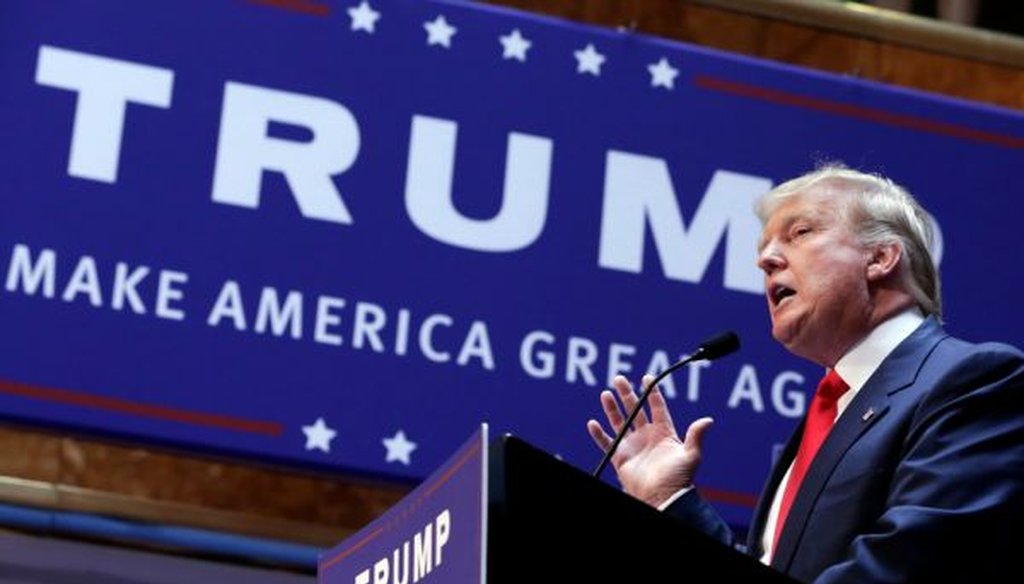

Our only agenda is to publish the truth so you can be an informed participant in democracy.
We need your help.


Donald Trump gestures as he announces that he will seek the Republican nomination for president on June 16, 2015, in New York. (AP/Richard Drew)
Don’t trust government unemployment statistics, Donald Trump said during his presidential campaign announcement speech.
"Our real unemployment is anywhere from 18 to 20 percent," Trump said. "Don't believe the 5.6. Don't believe it."
We’ve previously debunked the notion that the government somehow cooks the books when it calculates the unemployment rate. But is there a legitimate statistic that reaches as high as 18 to 20 percent? (Trump's staff did not return inquiries from PolitiFact.)
As it happens, there are measures of unemployment beyond the familiar unemployment rate (which, we’ll note, is actually 5.5 percent, not 5.6 percent as Trump said). However, none of the more expansive measures comes close to the level Trump suggests.
The most expansive statistic calculated by the Bureau of Labor Statistics, called the U-6 rate, is sometimes offered as a more "complete" picture of joblessness. It doesn’t just include those BLS officially considers "unemployed" but also those working part time for economic reasons as well as those who are "marginally attached" to the work force, meaning they want to work but have not looked for work recently enough to count as being actively in the labor force.
Currently, the U-6 rate of "labor underutilization" is 10.8 percent. That’s higher than the more familiar 5.5 percent unemployment rate, but it’s also well below the 18 to 20 percent Trump claimed.
So is there another credible way to calculate it? Maybe.
One could assemble a more expansive measurement of under-employment than U-6 -- one that ropes in even more Americans whose job outlook has been affected by the weak post-recession labor markets. For instance, U-6 doesn’t count recent graduates who never entered the labor market in the first place because they feared there would be no jobs for them, and it doesn’t count people who chose to take care of their kids full-time, went back to school or retired early to avoid having to compete for a job.
Pinpointing the size of this group is not possible given the type of data BLS collects, but we can at least calculate something approximating an upper limit.
To do this, we can use data that shows the number of people 16 and over who are "not in the labor force" -- that is, those who are neither working nor looking for work. If you take the number of people in this category at the beginning of President Barack Obama’s term and compare it to the number today, it gives a sense of how many people have shied away from the workforce in the wake of the last recession.
In January 2009, there were 80.5 million Americans 16 and over who were not in the labor force. Today, that number is slightly below 93 million. So the number not in the labor force has increased by about 12.5 million.
If you factor this number into the U-6 calculation (and subtract the "marginally attached" category to avoid double counting) you get a back-of-the-envelope rate of 16 percent.
But even this is almost certainly too high, since that would assume that every one of those 12.5 million Americans staying out of the workforce in the Obama years has done so because of the poor job market. In reality, we’re in the midst of the first big wave of Baby Boom retirements, so a share of those 12.5 million likely reflect this historically large pool of retirees.
For the sake of argument, let’s assume that half the additional increase in people out of the labor force comes from the Baby Boom retirement surge. That would mean the "new" unemployment rate -- perhaps we can call this new statistic "U-7" -- is about 13 percent.
Other guesstimates would produce slightly higher or lower percentages, but the important thing is that the numbers in this range are well short of the 18 to 20 percent Trump mentioned.
Getting the number up to 18 or 20 percent would probably require roping into the count people who are high-school and college students and people who are happily retired -- that is, people who technically aren’t working, but who have no reason to be. And that’s a bridge too far.
"A candidate for president should know the definition of unemployment," said Tara Sinclair, a George Washington University economist.
Our ruling
Trump said, "Our real unemployment is anywhere from 18 to 20 percent. Don't believe the 5.6. Don't believe it."
Setting aside his paranoia about the federal government cooking the books, Trump is off-base even if you give him the maximum benefit of the doubt. The highest official government statistic for under-employment is 10.8 percent -- roughly half as high as Trump says. And if you make a quick and dirty attempt to expand the scope of this measurement to include other Americans left uncounted in the standard statistics, there’s no plausible way to get it past 16 percent -- and even that’s stretching it. That’s well below the range Trump cited, so we rate the claim False.
Donald Trump, presidential announcement speech, June 16, 2015
Bureau of Labor Statistics, "Labor Force Statistics from the Current Population Survey" (main index page), accessed June 16, 2015
Email interview with Tara Sinclair, economist at George Washington University, June 16, 2015
In a world of wild talk and fake news, help us stand up for the facts.
